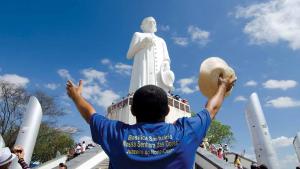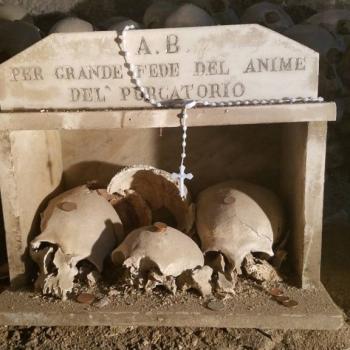
Beatification News by Eduardo Lima
In a country where people have revered folk religious figures for centuries, Padim Ciço — or Father Cícero Romão Batista (1844-1934) — has been the greatest of all Brazilian folks saints. Every year, 2 million devotees visit Juazeiro do Norte, the city he founded in Ceará state, in order to thank him for a cure or some other miracle granted through his intercession. Over time, practices became ritualized: People go first to the local churches to pray and then to the giant sculpture that portrays Padim Ciço. There, they tie a ribbon at a specific spot, with the hope that their problems will be solved when the ribbon is untied.
The whole phenomenon was never directly supported by the Catholic hierarchy. But now, almost 90 years after his death, Padim Ciço may officially become a saint. In August, the Holy See informed the Diocese of Crato that there are no obstacles impeding the cause of his beatification, allowing the local church to launch the process for Padim Ciço’s recognition as Blessed Cícero, the first step toward his canonization.
For years there had been several obstacles to Batista’s canonization, many originating in controversies that began when he was still alive. Batista settled in 1872 in Juazeiro do Norte, then simply an abandoned district of the city of Crato, though it was situated in a fertile valley in the middle of a very dry region. Batista’s steady work to develop agriculture in Juazeiro over the years attracted new families, many of them fleeing severe droughts in Ceará and neighboring states in northeastern Brazil. Most were also trying to escape violence and poverty. The region’s lands used to be in the hands of a small number of big landowners, who maintained large masses of peasants in extreme poverty.
“He would welcome all of them with joy and a charitable spirit. Batista rapidly became an important leader who worked hard to develop the local economy and secure the means of subsistence for everyone,” Casimiro said. Batista imported more productive strains of sugar cane and yucca from other states, incentivizing the modernization of farming methods in an area severely limited by state negligence and ignorance. “Today, Father Cícero would be like the founder of a great nongovernmental organization or a social pastoral ministry that helps the poor,” Casimiro said.
Batista’s careful work with peasants and his tenderness with them — in an era when priests were often austere and inaccessible figures — made his fame grow all over the sertão, the dry zone of the northeast. His nickname padim comes from his kindness: It means “little priest” and also “godfather,” a signal of his closeness to the people. “After a few years, rich people began to give him lands and money to contribute to his work. He became a wealthy, powerful man — but he always used everything to help the poor,” said the Rev. Wesley Barros, vicar of the Crato cathedral. “When new people arrived looking for his help, he would simply give them a house and land.”
In 1889, Maria de Araújo, who had received the Communion wafer from the priest, said it turned into blood in her mouth — and she kept the handkerchief with blood stains. According to de Araújo, this phenomenon occurred 46 more times over the next couple of years. A committee was formed by the diocese to investigate the alleged miracle and concluded there was no plausible explanation, that it was simply the result of God’s grace. But the local bishop appointed another group to analyze the events, and the group decried the claim as fraud. The bishop then suspended Batista from the priesthood and cloistered Maria de Araújo.
“He complied with the order and ceased to administer the sacraments. But he maintained his charitable work and his commitment to the people — who continued to see him as a saint,” Barros said. In fact, the “miracle of Juazeiro” greatly accentuated Batista’s fame as a holy man. Thousands of people traveled to the city to see him and ask for his blessing — and many ultimately chose to settle there.
The Catholic hierarchy did not know how to deal with his growing fame and ordered Batista to leave Juazeiro do Norte. He defied the Church and remained becoming an important political leader in the region. The combination of his holy status and his powerful social influence led the Vatican to issue an excommunication order against him. But Batista was in poor health by then and the local bishop never followed through on the excommunication, according to Barros. “The problems which led to that controversy were far in the past. The bishop explained his reasons to the Vatican after three years, and the pope agreed and told the diocese to leave things that way,” added Barros.
After Batista’s death in 1934, the church continued to downplay his legacy. For decades, people were not encouraged to show their devotion to Padim Ciço. Parents were even forbidden to give their children the name Cícero or Cícera during baptisms. Yet, the large groups of pilgrims who came to visit Juazeiro do Norte throughout the year were welcomed by the local clergy. “The ecclesiastical officials had a very strict theological understanding at those times. They did not understand the exaggerated — and at times superstitious — practices of that very humble people from the sertão,” Barros said.
But over the years the pilgrims’ faith also matured, he said. The Juazeiro do Norte’s pilgrim’s pastoral ministry became an active force and promoted a closer relationship between Padim Ciço’s devotees and the formal Catholic world. Since the beginning of this century, a new generation of bishops began a process to rehabilitate Padim Ciço in the Vatican. Documents and reports produced by researchers such as Casimiro were sent to Rome to demonstrate Batista’s integrity as a man of faith and his relevance as a holy figure in Brazil. “He was not ‘pardoned’ like Galileo Galilei, for instance, but there was a reconciliation,” Casimiro explained.
The Vatican did not have any formal complaint against Batista but never acted to stimulate the beatification process, according to Barros. A few years ago, the new bishop of Crato, Magnus Lopes, decided to ask Pope Francis directly about Padim Ciço’s sainthood. “The Catholic Church is going through a synodal process. How could we remain deaf to the pilgrim’s cry regarding their wish to revere Padim Ciço? That certainly touched Pope Francis’ heart,” Barros said. The Vatican responded to the message with the authorization to launch the cause of Batista’s beatification. In November, the Diocese of Crato will begin to receive testimonies concerning Padim Ciço’s miracles. There will certainly be thousands of them.
“My mother was very ill a few years ago. No physician seemed to be able to discover what was her disease. I begged Padim Ciço for a diagnosis,” Dinalva Rodrigues, 45, told Religion News Service. A resident of Teresina, Piauí state (360 miles west from Juazeiro do Norte), Rodrigues has been visiting Padim Ciço’s city every year since she was 18. With the COVID-19 pandemic, she had to skip two years. After her prayers, her mother was finally diagnosed with diabetes. “Her sugar levels were finally controlled and she has not been infected with the novel coronavirus — thanks to Padim Ciço,” she said. Now, she plans to visit Juazeiro again to thank her benefactor.
Although most of Batista’s devotees are from the northeast part of Brazil, he is a popular figure throughout the country, mostly because millions of northeasterners have migrated away from the region since the 1950s — primarily to the larger cities in the southeast — in search of better work opportunities. I have been living in São Paulo for 28 years and I could never come back to Juazeiro. I used to visit it every year with my grandparents, who were great devotees of Padim Ciço,” said Adeilva Delmondes, who was born and raised in Ouricuri, Pernambuco state (84 miles south of Juazeiro do Norte). Delmondes had severe headaches as a child. Her grandmother told her to wash her hair with the holy water from Juazeiro do Norte. The headaches disappeared after that, Delmondes said. Since then, she and her family have received numerous graces with Padim Ciço’s intercession, she said. “The other day, a fire broke out in the house of my neighbor, who is a hoarder. My son and my husband called me to leave our house, but I stayed there praying to Padim Ciço. The fire was extinguished before hitting us,” Delmondes said.
Analysis by Andrew Chesnut
What’s missing in this story, of course, is an explanation as to why both the Church in Brazil and the Vatican would seek to beatify a defrocked priest who had even been ordered excommunicated by the Vatican? Since the 1970s the Catholic Church in Brazil, the largest on the population, has been hemorrhaging members to the point that since 2018 Brazil is no longer a Catholic majority nation with less than 50 percent of the population belonging to the Church. As I have detailed in my own research, the majority of those who have abandoned Catholicism have left for Pentecostal churches, so much so that Brazil is also home to the largest Pentecostal population on earth. More recently a growing number of Brazilians have exited the Church to be become Religious Nones, those with no institutional religious affiliation whatsoever.
A major reason for the election of an Argentine cardinal as the first Latin American pope was to halt if not reverse the decades-long precipitous decline in Church membership not only in Brazil but across the region, from Chile to Mexico. Nine years into his papacy it’s clear that Pope Francis, who hasn’t bothered to visit his native Argentina, has been unable to stop the bleeding. Part of the Vatican’s strategy to make the Church more appealing in the Americas, where half of all 1.3 billion Catholics reside, is to canonize more holy women and men born in the New World. Only a tiny fraction of Catholic saints were born in the Americas, in stark contrast to folk saints such as Padre Cicero and Jesus Malverde who couldn’t have been more Brazilian and Mexican. One of the better known examples of this strategy, initiated by Pope John Paul II who was acutely aware of fierce Pentecostal competition in Latin America, was the canonization of the Mexica man, Saint Juan Diego, who allegedly received the apparition of the Virgin of Guadalupe in 1531. The canonization of an Indigenous person was specifically aimed at appealing to Native Americans in Mexico and Latin America, who along with Blacks are the two demographic groups abandoning the Church in the greatest numbers.
In short, the beatification and eventual canonization of Brazilian folk saint Padre Cicero is part of the Vatican strategy to make the Church more appealing to Latin Americans in the context of massive membership losses since the 1970s. With Brazil and several other Latin American nations no longer Catholic majority, it would seem that this is a case of too little, too late.













